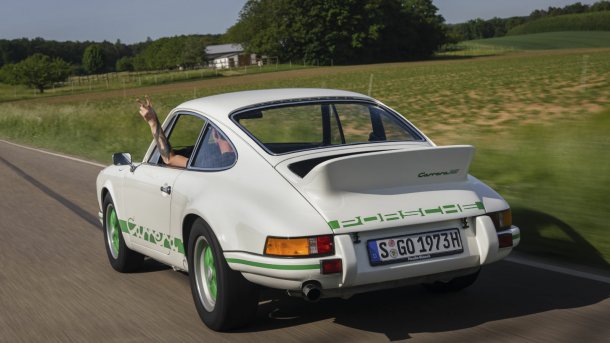Porsche 911 Carrera 2.7 RS: The good and the better
Old Porsches. "uhh", says the car enthusiast. But the popular shape caused questionable aerodynamics. The RS brought groundbreaking solutions in 1972.

(Bild: Porsche)
- Clemens Gleich
(Hier finden Sie die deutsche Version des Beitrags)
We interrupt our programme about energy prices, the role of the passenger car in society and its electric drives for a throwback to the Good Old Days (tm), when men were still real men, women were still real women and little furry creatures from Alpha Centauri were still real little furry creatures from Alpha Centauri. Please have your rose-tinted glasses ready, because there will be scenes with a very yellow Porsche 911 Carrera 2.7 RS "Touring".
Honour and Aero
But first the glasses have to stay down. We need the unclouded view through the clear glass, because it shows: In the seventies, the Porsche 911 was a design full of problems. Old Porsches had nothing to do with today's functional maturity of the design. Their weight distribution together with their idiosyncratic axle load change behaviour earned them the reputation of "tail skidders" because that's exactly what they liked to do: skid with the rear end breaking away.
The most annoying thing, however, was the aerodynamics. Much was written even then about the elegantly round lines, but the physicist sees immediately: the 911 looks like an aerofoil. Thus it generated lift like an aerofoil. The elegant nose also allowed a lot of air under the already light front (under 40 per cent axle load at the front), so that in the sixties Porsche had resorted to the desperate measure of fitting lead blocks in the front bumper of the 911.
"The car there below me was bucking".
Tilmann Brodbeck had joined Porsche in 1970. He had studied mechanical engineering and aerodynamics, and he wanted to use them to go either to Porsche or into aircraft construction. The first wish came true. "I remember with horror how the old hands initiated me as a newcomer," Brodbeck recalls. "We drove in 911s at over 200 km/h through the Kassel mountains. The motorway section was completely unrestricted back then. The way the car bucked under me there, that was pretty bad. But as a newcomer, I didn't dare let it go."
Even this early experience in his Porsche career revealed to Brodbeck the major constructional and functional problems with the 911. These soon became apparent in the field when competitors began to overtake the 911s in customer sport on the racetrack. This set off alarm bells in Zuffenhausen and Weissach.
(Bild: Porsche)
Company management: "Do something!"
"On the straights, the 911 could score with engine power," says Brodbeck, "but fast curves were faster in some competitor models. Of course it was impossible for a Ford Capri to overtake an expensive Porsche. I mean: The Ford Capri was a great car, but that still wasn't possible." The company management ordered the technology: "Do something!". The door closed and Tilman Brodbeck's supervisor told the new guy, "You heard him: do something!" And with that he left him standing there.
Italian inspirations
To ensure that the task was not too easy, the specification was also that the solution had to be retrofittable for existing customers. Brodbeck started with the front. In the wind tunnel, he experimented with pins, ropes and fingers to divert air to the sides so that less of it flew under the car. Based on the findings, the team made a front spoiler from GRP, which alone reduced lift by a third. A steel production part, however, would have required a year's tooling lead time.
(Bild: Porsche)
With GfK, on the other hand, there was concern that the accident properties would be too poor. A bump in the parking space would already destroy the component. Here Ferdinand Piëch made one of his striking decisions: "That's great. Then we'll sell more spare parts." And that's exactly what happened when the part for the 911 S made its debut. No customer complained when they had to reorder the front spoiler due to their own mistake.